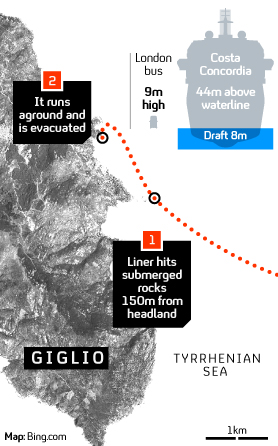‘Human error’ caused cruise ship accident
The CEO of Costa Cruises admits that he cannot deny “human error” in relation to the sinking of the Costa Concordia, as hopes fade of finding more survivors amid the wreckage.
Sixteen people are still missing after the vast liner smashed into rocks on Friday near the Italian island of Giglio, killing six and leaving more than 60 injured.
However, hopes of finding any more survivors are beginning to dim, after rescue efforts had to be halted in the afternoon as the hulk of the 114,500-tonne ship began slipping further underwater in the worsening weather.
The instability of the ship has also raised fears that the human tragedy could become an environmental disaster, although the Italian government said it would declare a state of emergency to help prevent this and release special funds. The environment minister also said proper monitoring was in place to thwart any leak risks.
Read more from Channel 4 News: How safe are cruise ships?
Fire brigade spokesman Luca Carli said the rescuers could hear no more noises from possible survivors inside the half-submerged ship, although search efforts have resumed.
“Obviously the more time passes, the less possibility there is of finding anyone alive,” he said.
Six people are confirmed dead after the tragedy, and the vessel’s captain, Francesco Schettino, was arrested on Saturday on suspicion of manslaughter and abandoning the ship before all the 4,200 passengers and crew on board were evacuated.
On Monday, the ship’s operators Costa Cruises blamed human error for the collision, although it said it would support the captain with any assistance he required.
“The company will be close to the captain and will provide him with all the necessary assistance, but we need to acknowledge the facts and we cannot deny human error,” Costa Cruises’ Pier Luigi Foschi told reporters at a press conference in Genoa. He also apologised for the disaster, and appeared to be fighting back tears as he said: “These ships are ultra-safe. It is an exceptional event, which was unforeseeable.”
Obviously the more time passes, the less possibility there is of finding anyone alive. Fire brigade’s Luca Carli
Human error
There has been speculation that Mr Schettino was sailing too close to Giglio to perform a “sail-by”, either to wave at those on shore or for “touristic” reasons, when the ship hit the rocks.
Costa Crociere also said Mr Schettino appeared to have failed to follow standard emergency procedures.
“The route followed by the ship was too close to the coast and it seems that his decisions on the management of the emergency did not follow the procedures of Costa Crociere,” said the company.
Mr Foschi added that the route taken by the ship was “unapproved, unauthorised and unknown to Costa”.

Italian Defence Minister Giampaolo Di Paola, a naval admiral, said the disaster did not appear to have been caused by natural or technical factors.
“In my estimation there was a serious human error, which had dramatic and tragic consequences,” he told RAI state television.
The captain maintained that the rocks the ship hit were not on his navigational charts.
His lawyer, Bruno Leporatti, said Mr Schettino was “overcome and wants to express his greatest condolences to the victims”.
But he said Mr Schettino’s actions in anchoring the ship at one end to swing it closer to the shore after the collision, “saved the lives of thousands of people”.
“It could have been an enormous tragedy,” Leporatti added.
The United Nations’ shipping agency, the International Maritime Organization, said it was important not to pre-judge the outcome of an inquiry but said it would examine changes to regulations if these were shown to be necessary.
A spokesman told Channel 4 News there was already a review underway of various things to do with passenger ship safety – and it would take into account the incident report on the Costa Concordia.
Pictures of the Costa Concordia tragedy
Recalling the sinking of the Titanic in April 1912, IMO Secretary-General Koji Sekimizu said: “In the centenary year of the Titanic, we have once again been reminded of the risks involved in maritime activities.”
Delays
The disaster occurred when the ship struck a rock as dinner was being served on Friday night, triggering scenes of panic that witnesses said were like the film Titanic, with passengers jostling to get on lifeboats and some leaping into the icy sea.
Passengers say there were unexplained delays in organising the evacuation of those on board and this had resulted in chaos.
The vast hulk of the 290-metre-long ship, half submerged and lying on its side, is still looming over the little port of Giglio, an island in a maritime nature reserve off the Tuscan coast. A large gash could be seen in its hull but salvage experts said its fuel tanks did not appear to have been damaged, lessening the danger of an oil spill in the pristine waters.
-
Latest news
-
‘Russian aggressions have never pushed Georgia to deviate from its own path’, says Georgian President5m

-
Why is Georgia’s ruling party so intent on adopting ‘foreign influence’ bill?5m

-
Trump’s lawyers try to paint Michael Cohen as liar out for revenge at trial3m

-
England’s schools told not teach gender identity2m

-
Slovakia PM shooting: Suspect charged with attempted murder3m

-




